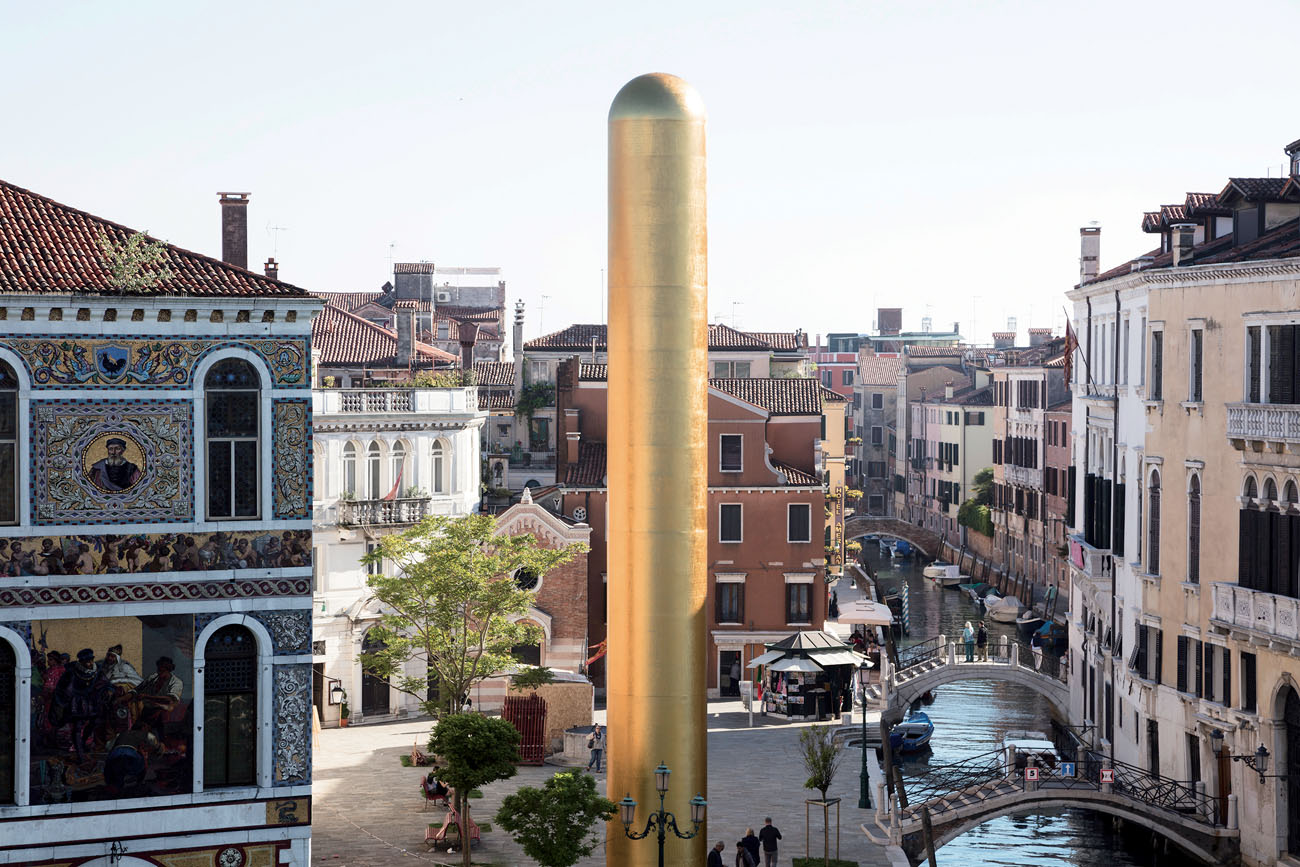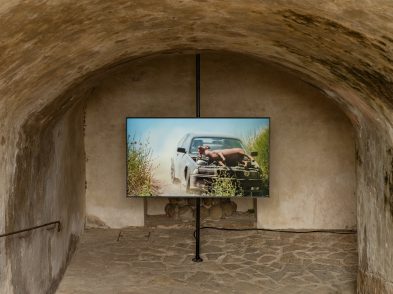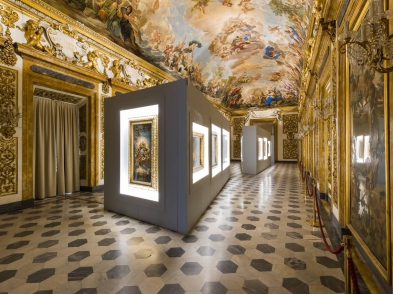Standing at over 20 metres and with its gilded surface, The Golden Tower by the American conceptual artist James Lee Byars is hard to miss. Until November 26, this elegant column rises with simple perfection from the pavement of Campo San Vio as if to connect the teeming streets around the Grand Canal in Venice—and the thousands scurrying between the multitude of venues scattered across the islands hosting events, exhibitions and installations—with the blue, mystical infinity above. If only this year’s Venice Biennale could be as inspiring a spectacle.
The Golden Tower’s arrival is not just a blessing for visitors who habitually lose their bearings in this magical city; it is a very visible temporary landmark. It has other values, one being its unhurried calm amidst the heave and pull of this robust city’s diverse and discordant human activities. Byars conceived the tower as a “monument to humanity”.

Richard Ivey, courtesy Michael Werner Gallery, New York and London
Another function of this astonishing art object is to ask many questions—about its own existence, even. And questioning is the foundation upon which memorable art is built. As metaphors spiral around every Biennale like urgent flights of urban pigeons, Byars offers a succinct motif. Supplying answers, however, is not a requirement of art.
The artist, who died in 1997, was a disciple of the post-war avant-garde. He sought to discard the distinction between art and everyday experience, and so unify them. In that way too, Byars’ spiritual presence could have inspired a truly astonishing Biennale, had this festival’s organisers followed his example.
Some artists have, however; these participants have contributed the highpoints, frequently with strikingly understated work. One such piece is Lost and Found, the modest but memorable installation in the Kosovo pavilion by minimalist artist Sislej Xhafa. The bare, brick-walled room in the historic Arsenale contains a kiosk constructed from simple wooden pallets, like those used to transport goods, wrapped in plastic. On the counter is a solitary telephone; it never rings. For the attentive spectator, its silence pierces the hubbub of its wider location to project thoughts about the victims of conflict—a sad feature of the present day—and those still living who yearn for the return of loved ones.
Unlike Byars, whose work is a collateral event, Xhafa is part of the Biennale programme involving 85 national pavilions and countless associated shows. So, too, is Vajiko Chachkhiani’s small wooden house from the Georgian countryside re-constructed in that country’s pavilion (actually, another room). Complete with furniture, pictures and other objects of a simple life, the otherwise deserted house is engulfed in ceaseless rain, on the inside. A weak yellow light illuminates the interior, visible through windows, and the contents will be inexorably altered during the coming six months, many broken down by the simulated downpour. As moss gathers indoors, the exterior of the house will stay the same. Chachkhiani’s installation transmits parallel ideas, about absence and migration perhaps, but also about artistic practice, a process that is equally physical and intellectual, and which releases constant change, as it were, from the inside.
Change is also a feature of Geoffrey Farmer’s treatment of the Canadian pavilion, ostensibly one of the permanent structures in the Giardini, the area that traditionally hosts the core of the Biennale. But Farmer has partially dismantled the building, opening it to the elements. Planted inside the shattered remains are a grandfather clock and a fountain that sends jets of water high into the air to catch the unwary. More metaphors to unearth, about time and permanence maybe, but in an infectious and subversive spirit of fun aimed at the art world’s tendency to take itself more seriously than is either healthy or warranted.
That spirit could have aided the experience of the long, long route through Viva Arte Viva, the central exhibition that unfolds through the biggest pavilion in the Giardini and continues into the Arsenale’s main building, the former rope factory of the Venetian navy. Here 120 artists jostle for individual attention and struggle to harmonise with the show’s theme, which if it can be distilled into a Byars-type question (minus that artist’s searching complexity) approximates to “what is it to be an artist?” .
The show is divided into nine sections designed to “flow together like chapters in a book”, according to this year’s director, the leading French curator Christine Macel. Gathering like-minded artists (should that phenomenon exist) into “families of practice” are consecutive pavilions (the show is a thesaurus of terminologies), moving from “artists and the book” to “time and infinity”, with “joys and fears” and “shamans” among other headings visited on the journey.
Along the way, visitors encounter giant screens and a big tent to chill out in, lots of thread and people sewing, green lights and gold nets, vast swathes of fabric and eruptions of colour. They will emerge from this experience with shades of an answer to that fundamental question while seeking its relevance to the unsettled world they are stepping back into. One obstacle is the impenetrable prolixity of too many wall texts; it is better simply to trust sight and hearing. Another is the difficulty of making sense of intricate objects dwarfed by the vast spaces around them.
Some works succeed. Edith Dekyndt masters her space with a mixture of theatre, simplicity, beauty and assumed profundity. Using insubstantial, ephemeral materials, she nonetheless endows a rectangle of dust on the floor with weight and magnitude, helped by light from a moving projector and an attentive performer who patrols the carpet’s perimeter, delicately sweeping the dust to keep the shape both within the beam and the viewer’s concentration.
Others surprise. Liu Ye’s paintings of blank book covers and empty open pages emit contradictory sensations of settled calm and the threatening presence of censorship. Kader Attia has set up multiple monitors on which black-and-white films are screened of a singer performing in Arabic while beneath grains of couscous dance on a drum-life surface to the rhythms of her voice. Hajra Waheed’s paintings of land and sea in different media on tin and Masonite, alongside hundreds of negative glass slides in rows on shelves, imply place and migration, peace and impending disruption.
The Biennale has grown so vast that seeing has been replaced by scanning and sampling; no two visitors leave with the same impressions or favourites. So the award of prizes is controversial. An august jury judged Germany’s pavilion the winner. In Anne Imhof’s complex and intimate installation performers engage in movement, gesture and action upon, above and below the elevated glass floor across which the public carefully walk. Top prize in Macel’s central show went to another German, veteran minimalist Franz Erhard Walther. He uses fabric, form and colour to transform common ideas about objecthood and perception, often by requiring the viewer’s physical interaction with the work.
Having devoted valuable hours or days in their finite lives to looking, queuing, wondering, dozing, cooling and searching, many spectators will disagree with these outcomes. Debate is the lifeblood of creativity and many voices spoke up for painter Mark Bradford’s American pavilion and its bold, obstructive, gutsy and polemical abstract paintings that transform the classical-style interior with big canvases and massive tresses of bleached and painted, twisted and coiled paper into a kind of grotto into which established social structures appear to have collapsed.
Of all the media available to contemporary artists, video seemed best suited to the Biennale’s dominant architecture. Candice Breitz’s Love Story in South Africa’s pavilion is outstanding: famous actors narrate the stories of refugees. The panoramic video by New Zealand’s Lisa Reihana, inspired by 19th-century wallpaper depicting Captain Cook’s voyages, is technically remarkable and portrays critically the first interactions between indigenous Pacific peoples and the Europeans who colonised their land.
Finally, Romania deserved a gold-palmed pat on the back for selecting Geta Brătescu who, at 91, is suddenly attracting international acclaim. A veteran modernist, her work is penetrating, vigorous and hand-made—drawn, painted, stitched, folded and assembled. She fills a sizeable pavilion with acerbic, expressive ink sketches, extraordinary self-portraits and collaged images of women, some drawn with eyes closed.
Every flat terrain is articulated by its highpoints. This year’s Biennale was as open and unremitting as a prairie. But, at its best, it chimed with the hope that illuminates both the triumph of age and the migration of peoples on the arduous path to better futures.
57th Venice Biennale
International Exhibition of Art
Until November 26, 2017
Giardini, Arsenale and other venues across the city
Website






